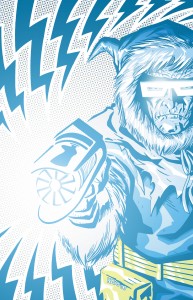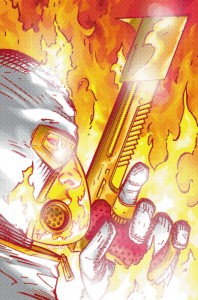![]()
When Geoff Johns and Scott Kolins took over The Flash in 2001, they set about redefining two things: Keystone City, and the Flash’s Rogues. Johns has a talent for taking a concept, finding the core of what makes it work, and refocusing on that without throwing everything else away. Suddenly, a guy who wears a parka and carries a cold gun, another who dresses in orange and green and carries trick mirrors, and another who wears bright green and controls the weather became credible threats and interesting characters — all without a world-shattering retcon*. Sadly, that aspect has been missing in the treatment of the characters for the last few years.
Johns and Kollins have reunited for Final Crisis: Rogues Revenge, and the book feels like they never left. Originally designed as a stand-alone miniseries that would resolve lingering plot threads from Full Throttle and Salvation Run, it’s been tied into Final Crisis.
The setup is simple: The Rogues are tired. They’ve been through hell, and they’re ready to get out of the game. But there’s one thing they have to do first: Get back at the kid they feel is responsible for their current state: Inertia, who talked them into the caper on which they killed a Flash.
First-time Flash readers should have an easy time getting into the world. The book establishes who the Rogues are, what motivates them, and what their powers are right in the first few pages. Long-time readers will enjoy seeing characters like Iris Allen, or Keystone City’s Department of Metahuman Hostilities (basically, the cops’ Rogue specialists).
The book is dark. (Often literally, since most of it seems to take place either at night or in the rain.) It’s about villains. The only heroes who appear are in flashbacks, except for the Pied Piper, who’s ridden the line between hero and villain for years, and the police. There’s a truly chilling scene when the book picks up Inertia’s story. But it’s different from Secret Six or Villains United in that those were primarily action pieces. This reads more like a crime drama with costumes — say, an episode of The Sopranos with freeze guns instead of swearing.
In some ways this book seems like a course correction. Sort of a “I handed over these characters and you did what with them? Here, let me fix it.” But while most of the first issue is setup, it’s working as a story.
The only drawback is that it’s hard to tell when this takes place. It’s firmly fixed in terms of Final Crisis, with references galore to the events in that series, but it’s less clear how it fits into the monthly Flash book. Presumably the editors have been coordinating, and this simply takes place after the current storyline, though DC hasn’t had a great track record over the last year. It’s only a minor irritant, though, unless you consider continuity to be more important than any other aspect of comic-book storytelling.
*I’m using “retcon” here in the sense of replacing a character’s history, not in the sense of filling it in. Because filling it in is exactly what Johns did on his Flash run.


 Geoff Johns and Scott Kolins have done a number of interviews about this summer’s Flash-focused mini-series, Final Crisis: Rogues’ Revenge.
Geoff Johns and Scott Kolins have done a number of interviews about this summer’s Flash-focused mini-series, Final Crisis: Rogues’ Revenge.